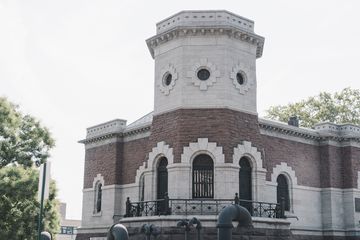Founded in 1968, the organization once known as Aaron Davis Hall, Inc. used to operate in a facility owned by City College New York. A fundraising campaign was initiated in 2000 to restore the stunning structure on the corner of 135th Street and Convent Avenue, built in 1890 as a part of the Croton Aqueduct system, and transform it into a space for performing. Six years later, the organization's efforts came to fruition when it moved into the new Gatehouse facility and officially renamed itself Harlem Stage. When the Manhattan Sideways team toured the space in the summer of 2017, we were impressed by how seamlessly the historic attributes of the building were merged with the modern needs of the renovated theater. In particular, I had to admire the door with the antique, elaborate hinges set into the wall of the staircase leading to the stage on the second floor. It came as no surprise to learn that Harlem Stage had been honored by the New York Landmarks Conservancy for the remarkable job that it did in preserving the original structure. Executive Director Patricia Cruz told us that spearheading the movement to transform the building “from a community eyesore into a community jewel” has been one of the most significant accomplishments of her tenure. Even so, she added, “It is not as important as what we do inside. ” Upon moving into the Gatehouse, Harlem Stage launched the WaterWorks series - “Our most identifiable program, and what makes us unique, ” Patricia explained. Appropriately named in homage to both the facility’s past and its current role as a conduit for culture and artistry, the program serves to find and present new work. In the ten years since its creation, it has commissioned and supported fifty artists, five of whom went on to become MacArthur “Genius” Fellows. Monique Martin, director of programming, emphasized that the WaterWorks series identifies an artist as extraordinary and encourages new, original work in the process. “Our identifying them before the rest of the world did is a sign of our curatorial excellence, ” Patricia added. The staff at Harlem Stage take pride in their ability to incubate new artists, especially artists of color, and support them through offering mentorship, frequent workshops, and plenty of available space to work. The two women stressed the importance of what they do, as “it is rare for artists of color to be given the resources they need to develop new work, which is so critical to the diversity in the field. ” Recognizing the significance of this mission, they are now embarking on a $10 million campaign to continue running WaterWorks for another ten years. While creating a platform for original work, Harlem Stage has also built an audience. Through programs such as Dig Deeper, they encourage the community to meet and interact with their artists while learning more about the process of putting on a performance through arranging open rehearsals, panel discussions, and more. Their efforts have paid off thus far, as their performances typically boast sold out audiences. “The identity of Harlem is part of the larger legacy of Harlem Stage, ” Patricia explained, which is why they place such importance on connecting with all members of the community. This focus is not limited to adults - the Frances Davis/Harlem Stage Arts Education program is centered on exposing children to the arts. The program serves 4, 000 children in the Harlem area annually and has reached over 400, 000 in total. Its goal is to try to fill the gap in public education caused by a reduction in funding for the arts. To this end, Harlem Stage sends teaching artists to schools and ask them to engage with students, upholding the philosophy that “all art is appropriate and available for young artists. ” Patricia mentioned that the question of age-appropriate subject matter is a common concern when creating youth theater programs. She maintained, “We’re selecting and curating an experience for them, but we don’t pander to our young audiences. ” Adolescents are also encouraged to participate in various high school programs that connect them with Harlem Stage’s production team, allowing them to learn the technical side of theater under the guidance of experienced mentors. These are only a small sampling of Harlem Stage's offerings, we were told, as the organization has taken pains to create “programming that has range and depth. ” Those at Harlem Stage provide opportunities within as many areas of the arts as possible, including dance, film, and music. By creating a space that is versatile and open to creative expression in all its forms, they hope to accomplish their ultimate goal - “to continue to build on the legacy that Harlem has made in our culture and that Harlem Stage has done since its inception. ”

